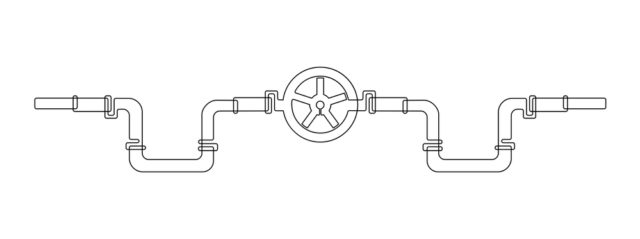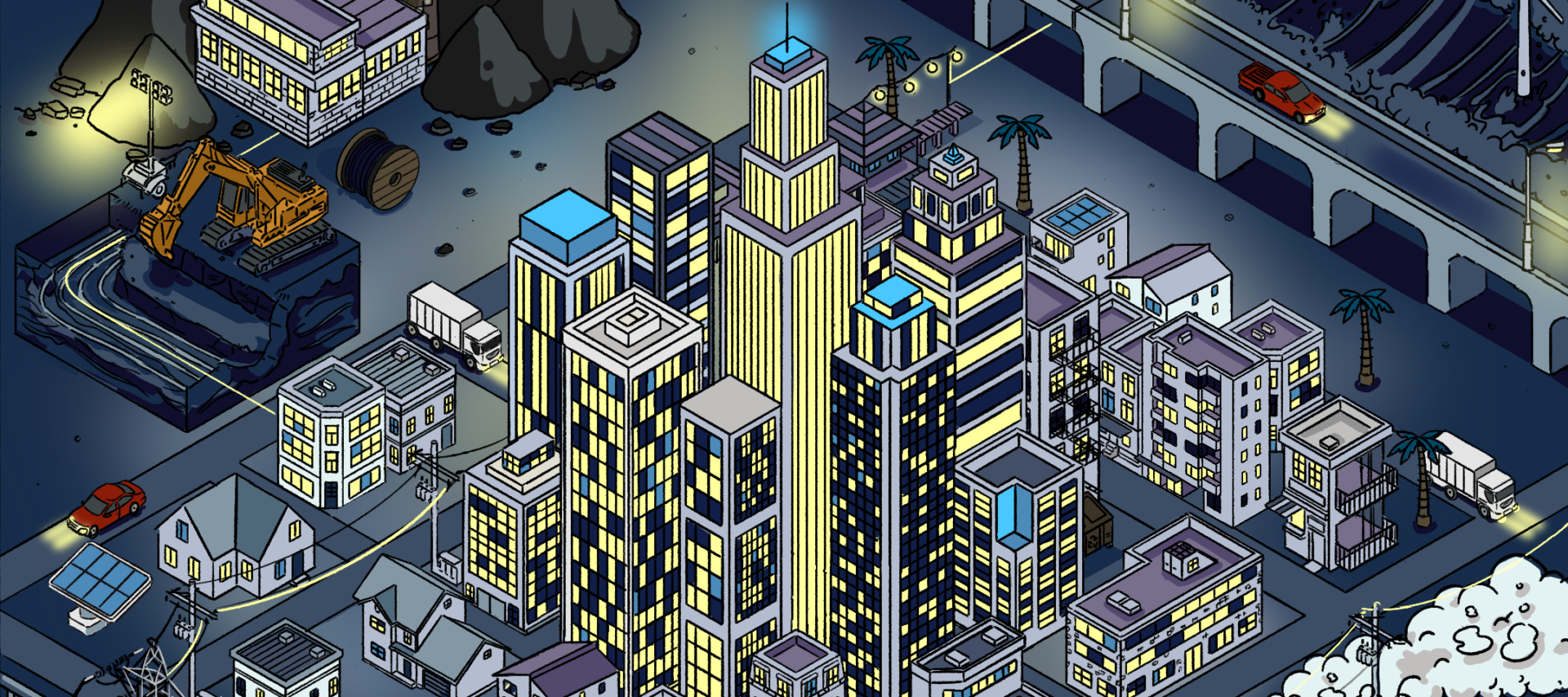

Put a bagel in a toaster oven and push a button. In a few seconds, heating elements inside the oven glow red and heat the bagel. The action seems simple — after all, ten-year-olds routinely toast bagels without adult supervision. Matters look different if you inquire into what must happen to make the oven work. Pushing the button engages the mechanism of an incomprehensibly vast multinational network: the North American electrical grid.
The numbers are dazzling. The United States alone has more than 6 million miles of power lines, enough to stretch to the Moon and back twelve times. An average U.S. single-family home contains almost 200 pounds of copper wire — and there are more than 80 million U.S. single-family homes. The Empire State Building alone has more than 470 miles of electrical wiring. And all these miles upon miles upon miles of wire and cable and circuit are so routinely and reliably coupled that most of us think nothing of the fact that southern California gets power from hydroelectric dams a thousand miles away in northern Washington State. Constructed over more than a century, embodying entire political and economic histories, the North American electrical grid may be the most complex object ever created by our species.
Despite its complexity, though, every bit of that vast system is focused on just one task: transmitting an electric current.
To create an electric current, rotate a coil of copper wire around a child’s bar magnet or, conversely, rotate the bar magnet inside the coil. Either way, the magnet’s magnetic field moves with respect to the wire. All of us know the solar-system image of an atom, with a central nucleus orbited by electrons. Metals like copper — conductive metals, as they are known — are different. The electrons aren’t tied to individual atoms. Instead, they float among them, like dust motes in sunlit air. In conductive metals, a moving magnetic field “pushes” the electrons through the metal in a direction dictated by the magnetic field. The result is an electric current.
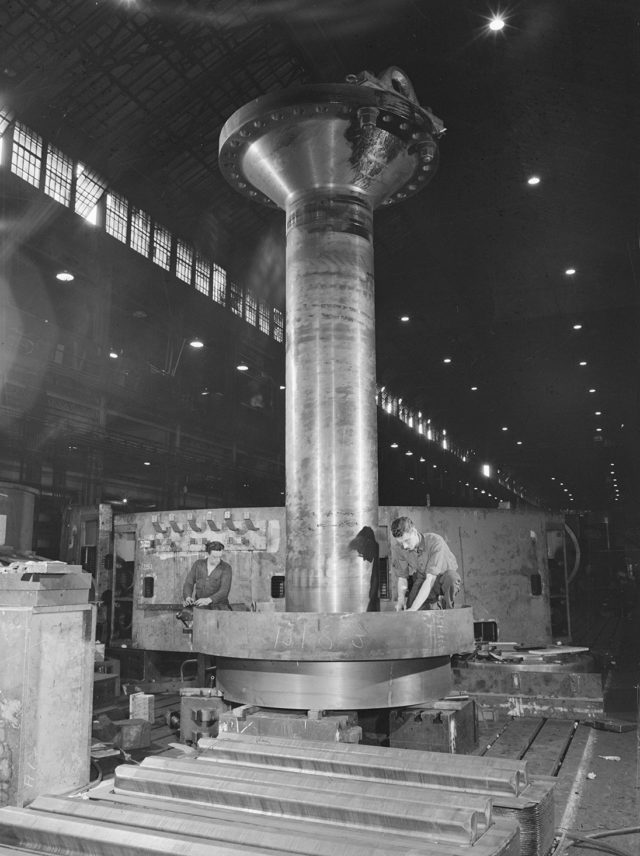
Electric generators, whether they are fueled by coal, oil, wind, water, natural gas, nuclear fission, or geothermal energy, all consist of the same two things: a rotor (a rotating part, as the name suggests) and a stator (a stationary part). One of these is a conductive metal, usually copper wire; the other is a magnet. The coal, oil, water, fission, and so on provide the power to spin the rotor around the stator, which produces electricity.
The big exception to this general rule is solar power. Solar power is primarily derived from photovoltaic panels, which directly convert the energy in sunlight into electricity. Rather than having rotors or stators, photovoltaic panels are made of “cells” of materials called semiconductors. When sunlight strikes the semiconductors, its energy knocks electrons free from their atoms. One surface of the panel is treated to make it receptive to the dislodged electrons, so they shift toward it. Electrons all carry a negative charge. When they move toward the treated surface, it becomes relatively more negative; meanwhile, the other side becomes relatively more positive. This imbalance creates a situation akin to the negative and positive terminals of a battery. When the cell’s terminals are connected, electricity flows through the circuit.
Whatever the energy source, making a current is straightforward, even easy — but everything else is a problem. Early electric utilities discovered this the hard way. The first commercial electric power plant in North America opened in Appleton, Wisconsin, on August 20, 1882. The second, built by the famed inventor Thomas Edison in Manhattan, opened two weeks later, on September 4. The Appleton plant, on the Fox River, was also the world’s first hydroelectric plant. The plant channeled the Fox’s current through the plant to turn a turbine — an axle with waterwheel-style blades. The turbine, spinning, turned a set of gears. The gears rotated a cylinder of conductive metal (the rotor) by six big magnets (the stator). An electric current emerged.
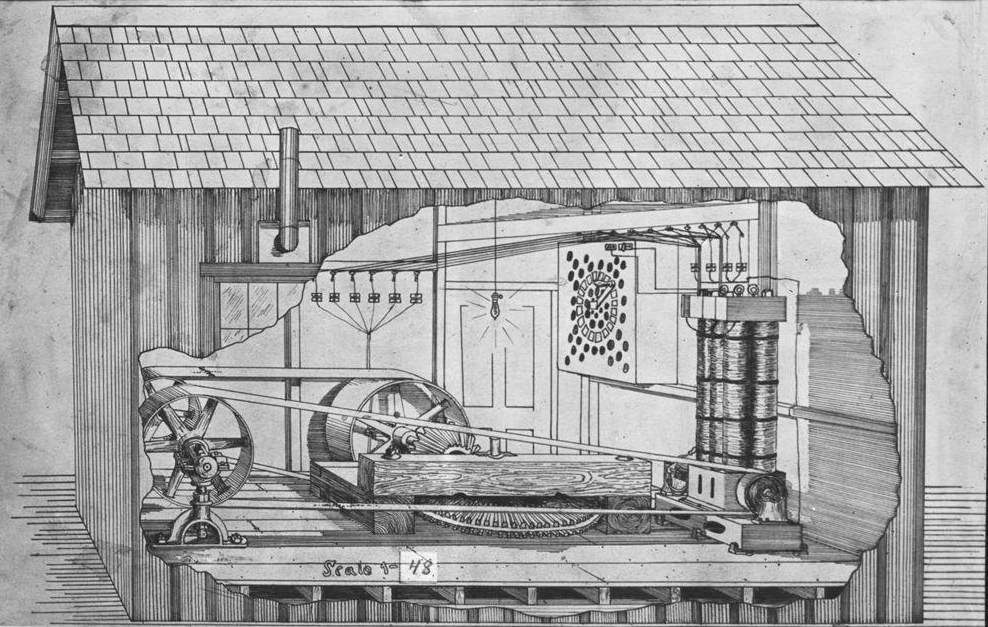
Edison made money from his patents on electric plants — his plant in Manhattan was mainly a demo. The people in Appleton had to cover their costs, which included paying Edison to license his patents, by selling and distributing electricity. This meant putting up big poles all over town and stringing wire on them, a pricey endeavor. Unfortunately, the costs didn’t go down as the customer base grew. Connecting the ten-thousandth home was nearly as expensive as the first.
Equally high were the costs of maintaining the system. The flow of electrons in a power line is not, so to speak, friction-free — it heats the metal, a phenomenon called resistance. (Resistance is why the elements in an electric range glow red and get hot.) If resistance heat can’t dissipate, a metal wire will soften, expand, and lengthen. If the wire is a power line, the heat will make the line sag between its supports. If the line droops too low, it can spark out onto nearby trees or other objects, causing a spike in the current or shorting out the line entirely. Today’s electric cables reduce the risk of flashes by being built with a complex multilayer design and sheathed with insulation. But sagging power lines are still responsible for a large fraction of the big wildfires in the West.
Swamped by the costs of building and maintaining infrastructure, the Appleton plant went belly-up in 1896. So did a host of other early utilities. Customers were furious. The upheaval lasted for decades — one reason why today’s utilities are heavily regulated and, often, publicly owned. It is also why the national grid is a patchwork jumble of older and newer elements, all hooked together higgledy-piggledy as they developed.
Today North America’s more than 12,500 utility-scale electric power plants are divided into three primary, semi-independent electric grids. One, in the east, runs from Ontario to Florida. A second, in the west, sprawls from western Canada to Baja California. The third, in most of Texas and bits of northern Mexico along the Rio Grande (not shown on the map below), stands between the other two. A few other places — Quebec and Alaska, for example — have their own, smaller grids.
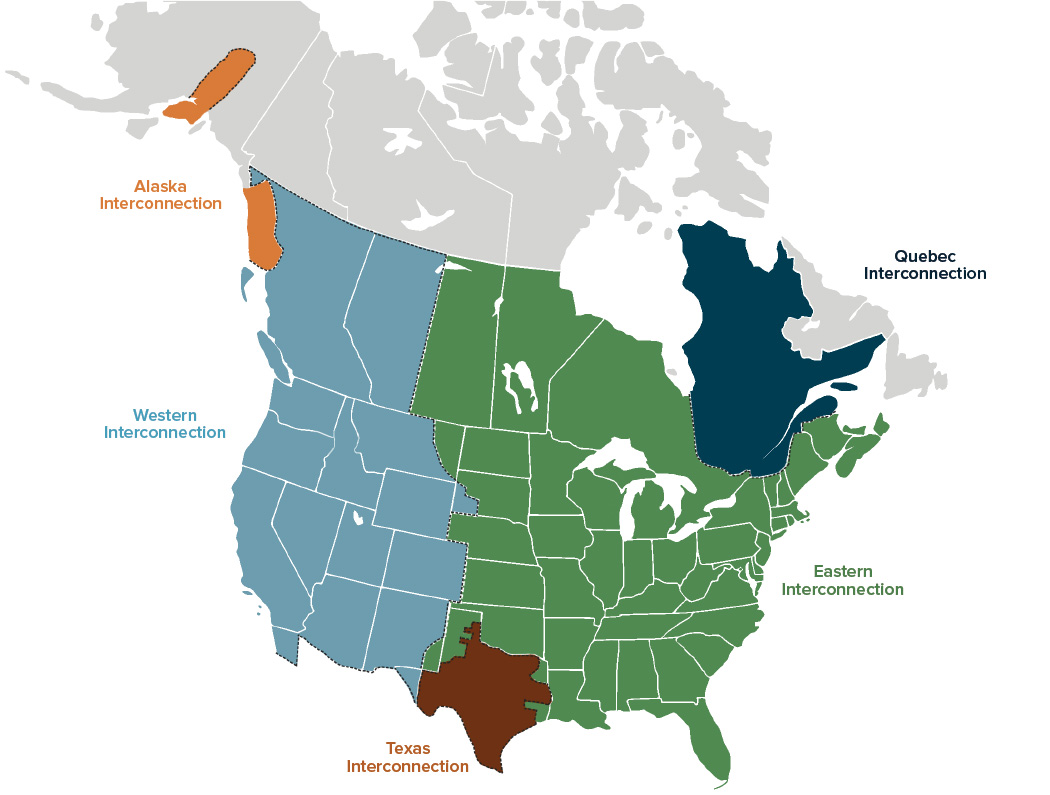
The three big grids have little interconnection with each other and the smaller grids, and they don’t follow the same rules. A severe cold snap in 2021 froze up many coal- and gas-fueled power plants in Texas, causing a huge blackout. Oklahoma and New Mexico next door had plenty of spare power, but because they were part of another grid they had no way to send it quickly where needed. The crisis lasted almost two weeks. North America’s electric system is a miracle, but also kind of a mess.
Appleton’s generator was in a one-room shack. The generator and its controls were to one side. Hanging from the ceiling in the middle of the room was a bare electric light bulb to serve as a warning signal. Fluctuations in the river’s flow would make the waterwheel spin slower or faster, changing the speed of the turbine and making the bulb dim or flare. The operators were supposed to compensate by adjusting the waterwheel to speed up or slow down the turbine. Sometimes they didn’t compensate fast enough for a sudden rise in the river’s flow. The resulting power surge would blow out light bulbs across town. Customers didn’t like the blackouts. They really didn’t like replacing those early light bulbs, which typically cost the equivalent of $35 today.
Electric utilities now are vastly more sophisticated. And they now provide power to devices — motors, computers, appliances, heating and ventilation systems — that Appleton’s investors never imagined. But utilities today still face those same problems. All those new devices require a steady, constant current, just like Appleton’s light bulbs. Pulses, variations, gaps — all can fry the motor, burn out the heater, brick the computer. A sag or surge of even a few percent can be too much.
Minute by minute, power plants have to produce just about exactly as much electricity as is being used at the moment. Too much electricity is as much of a problem as too little. Water systems maintain a continuous flow by storing extra water in reservoirs, releasing it when needed, taking it in when there is surplus. For electricity, the equivalent of a reservoir is a battery. Battery costs have fallen in recent years, but storing electricity remains much more difficult and costly than storing water. As a result, electric power is still mostly generated, transported, and used in real time. The energy you use to turn on your monitor was a ray of sunshine or a puff of natural gas just milliseconds before.
Every time a big building — a factory, say, or a stadium — switches on its lights or heating system, it suddenly draws power from the network. The same happens when thousands of commuting workers come home and simultaneously turn on their air conditioning. And it happens in reverse when the factories, stadiums, and homes turn off their lights and heating — power is abruptly released into the grid. Generating a steady current while simultaneously matching it to demand with no backup is an amazing technical feat.
The people who accomplish this feat work at what are called reliability centers. Scores of these operate across North America. Inside them, people oversee the grid, ramping up or reducing activity at power plants and shunting current around electric lines like air traffic controllers guiding planes. In a sense, they are doing the same thing as the people in the shack at Appleton who sat and watched the light bulb — except that the “shack” is wallpapered with computer screens and they are watching, so to speak, countless millions of light bulbs.
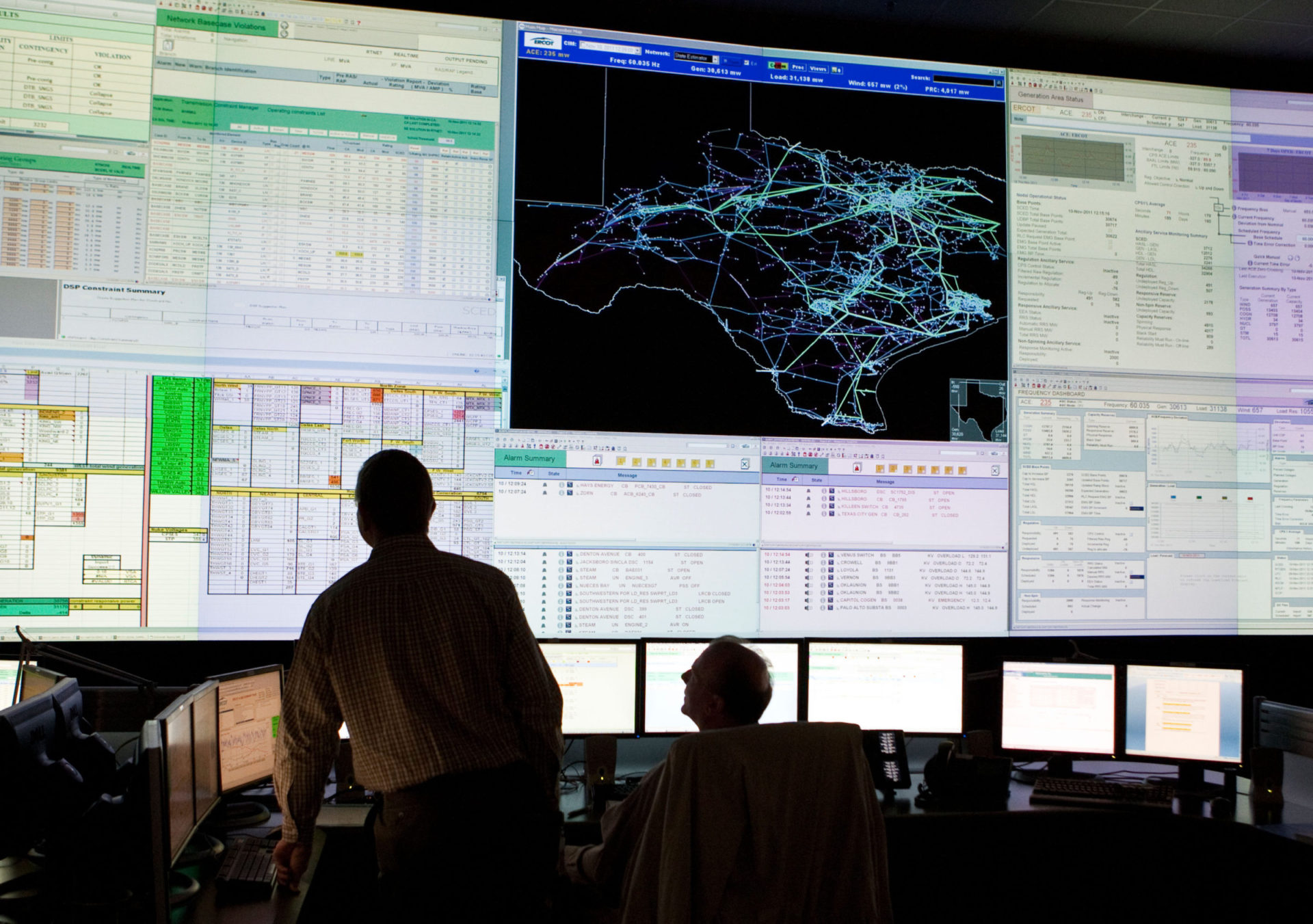
The centers’ work is never-ending, because every part of each grid is connected to every other part, and all are constantly changing how much power they need or produce. We switch on our lights and computers without thinking about it. But that smoothness and reliability is the result of the invisible, watchful labor of thousands of people. There are countless points where things can go wrong — and do. Fast.
On August 14, 2003, an operator at a reliability center in Ohio was fixing a software problem just before his lunch break. After he finished his work, he forgot to switch on a control system he had turned off during the repair. At 1:31 p.m., a coal power plant went offline. This required importing power to the area from elsewhere, which put more load on the power lines, causing more sag from heat resistance. Ninety minutes later, in an all-too-common occurrence, an overhead power line sagged into an overgrown tree. The line shorted out in a shower of sparks. Nobody in the reliability center noticed, because the control system wasn’t on to alert them. Even when operators realized the problem and turned it on, the control system delivered false readings of available power in the grid. In a separate, simultaneous bit of bad luck, an alarm function in the control room of the utility company went out. Now both the reliability center and the utility operators were flying blind and didn’t know it.
The current in that shorted-out line had to go somewhere. It flooded into other lines, which further sagged. Half an hour later, one of those lines, which hadn’t had the proper distance around it cleared of trees, hit a tree and stopped working. Thirty seconds later, a third line hit a tree and failed. Within half an hour, sixteen more lines failed as current from the other failed lines surged through them. Suddenly some parts of the grid had too little power, but there was no way to get it to them. By 4:11 p.m. the cascade of outages had spread as far east as New York and Massachusetts and as far north as Michigan and Ontario. Within four hours, a combination of software failure and small human errors had spiraled into a blackout that affected more than 50 million people.

The electric current in a power line can be thought of like the flow of water in a firehose. Much as the power of the water from the firehose is due both to its pressure and its volume, the power of an electric current is the product of its voltage (the “pressure,” so to speak, of the current) and its amperage (the “volume” of current).
Higher pressure will shoot water through a hose more forcefully. Similarly, higher voltage creates a current that can do more work. Big electric motors in factories require higher voltage than do small electric lights in homes. For early electric utilities like the one in Appleton, this was a problem. Because the Appleton waterwheel produced a fixed amount of current, it couldn’t power both low- and high-voltage systems. Utilities like Appleton faced the prospect of stringing separate power lines for each type of device.
Luckily, half a dozen Europeans solved this problem in the 1870s and 1880s. The steady-stream current from a turbine is known as direct current. The Europeans developed transformers, devices that could convert direct current to alternating current, in which electrons flow back and forth along the wire, switching direction many times a second.
Alternating current has a major advantage over direct current. Just as a moving magnetic field produces a flowing electric current, a current that shifts back and forth produces a magnetic field. That magnetic field can be used to create secondary electric currents with lower or higher voltage than the initial current. With transformers, a single power installation can power many different types of devices.
In addition, utilities can use transformers to raise the voltage and lower the amperage on their lines. Because lower-amperage currents create less resistance, the switch to alternating current allowed companies to lose less energy as they sent power through the system.
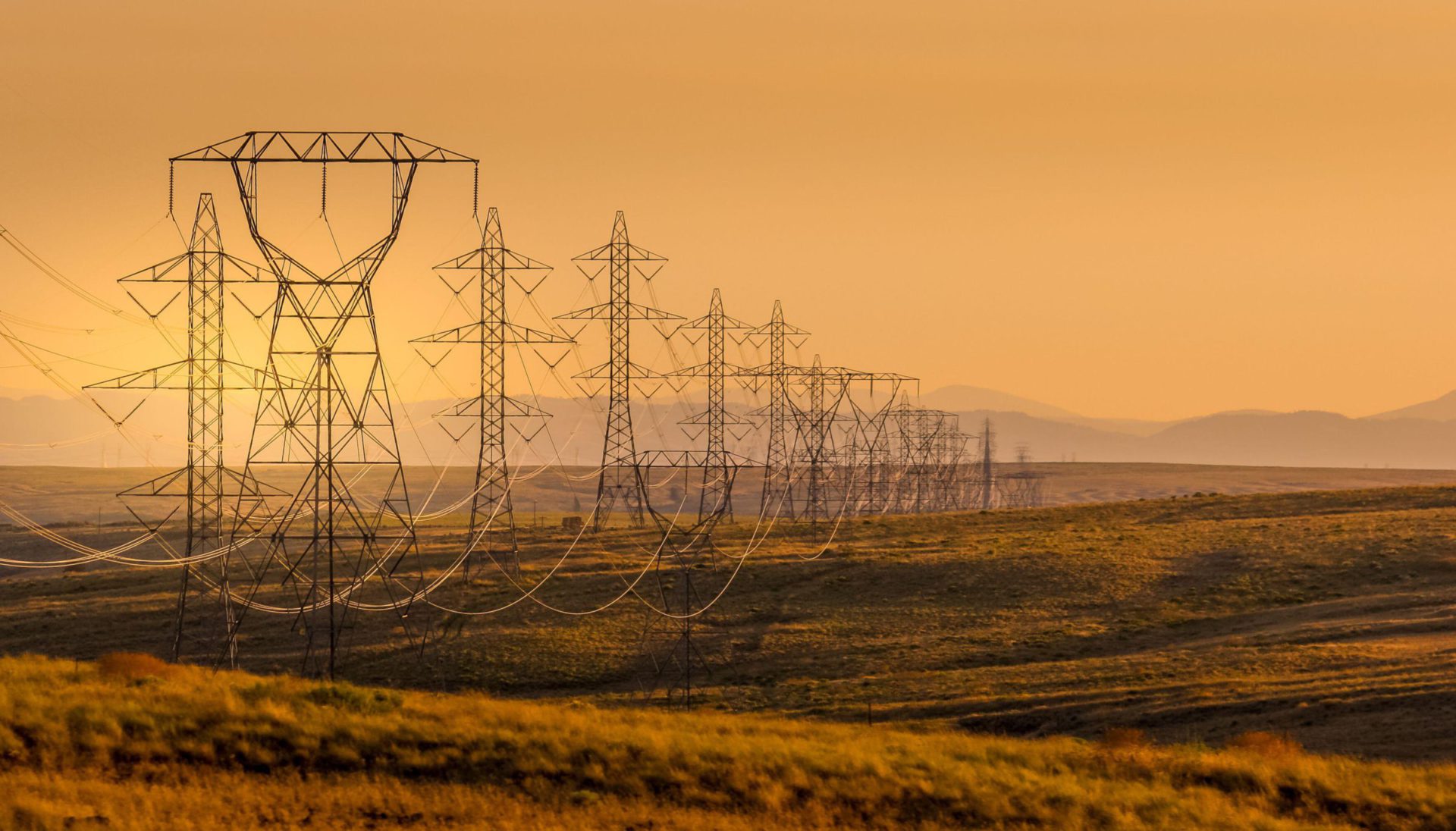
The switch from Appleton-style direct current to modern alternating current led to a wild fight. In what became known as the War of the Currents, Thomas Edison, whose plants used direct current, falsely claimed that alternating current was inherently dangerous. An engineer and Edison ally named Harold P. Brown staged spectacles in which he publicly electrocuted stray dogs to demonstrate the purported risks of alternating current. To discredit alternating current, Brown craftily promoted its use in the then-new electric chair and then campaigned against “executioner’s current.” Eventually, though, the superiority of alternating current for most then-known uses of electricity could not be denied.
Alternating current did add complexity. Many devices today work on direct current: cell phones, computers, flat-screen TVs, and electric cars. For each, alternating current must be re-converted to direct current. And even devices powered by alternating current need the frequency of the current — the number of times per second that the electrons go back and forth — to be precisely steady. The U.S. standard for alternating current is 60 times a second. Grid operators must ensure that this frequency remains precisely stable 24 hours a day, 7 days a week. Even 59 cycles per second can damage delicate machinery. When there are sudden drops and peaks in power demand, the fluctuations in the current are accompanied by fluctuations in frequency. Add frequency to the list of factors reliability centers must oversee.
Simply keeping the present system going requires constant watchfulness and expense. Unfortunately, that is not enough. According to the Census Bureau, the U.S. population will increase to between 360 and 380 million by 2050. Numbers in Canada and Mexico will also rise. The grid will have to be expanded to serve those new people. On top of that, most economists believe that the number of affluent people will also jump. Affluent people typically use more power — think of second homes, high-priced appliances, fancy entertainment consoles, and heated swimming pools. Think also of all the new data centers required to power the AI models that are now rapidly proliferating. Finally, society has been “decarbonizing” for decades — using less coal, oil, and gas in homes, businesses, and automobiles, and switching to electricity. All these factors will greatly increase the demand for electric power. The exact amount can’t be known, but typical estimates are that we will have to increase electricity supply by a quarter or more in the next twenty-five years, and keep increasing it thereafter.
This year, according to the U.S. Energy Information Agency, more than 90 percent of newly constructed U.S. power plants will use renewable energy — that is, energy from sources that are constantly restocked. (About 7 percent will run on natural gas.) When oil is burned or uranium has its atoms split in a conventional reactor to produce energy, the oil and uranium are consumed forever. Renewables, by contrast, draw on sunlight, wind, rivers, tides, or underground heat — energy sources that never need to be replenished (though the supply can be interrupted). Homeowners who heat with propane run out of fuel and must refill their propane tanks, but homeowners who heat with electricity from solar panels get new sunlight every morning.
Renewables have two primary advantages and one big disadvantage. The advantages are that they are inexpensive — indeed, their costs keep dropping — and they do not release climate-changing gases into the air. Their disadvantage is that they are, as a rule, variable: the amount of power they send into the grid shifts with the vagaries of sun, wind, and water. During droughts, hydroelectric plants often have to cut back. When storm clouds suddenly blot the sun, solar-powered grids must adjust. Because wind turbines’ rate of rotation changes with wind speed, their output is highly inconstant. To make their power usable, wind turbines pass it through circuits and batteries that “smooth out” the flow. Even then, wind farms often have to be shut off in high winds, because they produce too much power.
Critics of renewable energy argue that these extra levels of variability and complexity mean that renewable energy could destabilize the grid. Adding in the extra capacity needed to buffer their variability outweighs their initial cost advantage, skeptics say. In addition, critics are dismayed by the amount of land that wind and solar installations require. Instead, they argue that new energy should come from nuclear power, which doesn’t release climate-changing gases, uses little land, has no problems with variability, and has an excellent safety record — surprising to some, fewer people die from the production of a terawatt-hour of nuclear energy than of water or wind. Nuclear critics in turn argue that nuclear plants are stunningly expensive and that nobody knows how to safely dispose of the resulting waste, a fraction of which is highly radioactive. Some reactor designs propose to address these problems. Small, prefabricated modular reactors should ultimately cost less and there are designs for reactors that produce power from high-level waste. But as of yet very few of these types of reactors have actually been built.

How and what to build? Go all-in on renewables and bet that we can develop the technology to stabilize the grid? Push for nukes and bet that their price and complexity will go down? These questions are inherently subject to the political process. But before we can choose what to build, another issue must be faced: the ever-mounting obstacles to building anything at all.
Gas pipelines, high-tension wires, solar farms, wind installations, nuclear plants, petroleum wells, power substations — plans to emplace any of these spend years struggling through multiple levels of regulation, seemingly without exception. All too often they are then mired in litigation, especially if the projects are of any size. Some of the litigation is for good reasons. More than one pipeline firm, for instance, appears to have been careless about spills. One can readily imagine neighbors demanding safeguards. But all too much of the opposition appears driven by simple revulsion — people don’t like being reminded of the presence of systems that help keep them alive and comfortable. It is as if the United States is rebelling against its own energy infrastructure.
In turn, this springs from an act of society-wide forgetting — that every nicely toasted bagel we eat is made possible by decades of effort and the continuing presence of thousands of people who, almost imperceptibly, take care of a grid that sustains us all.
